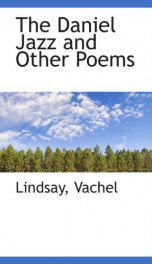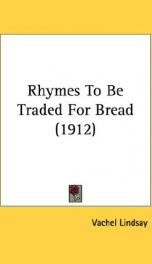Lindsay Vachel

Nicholas Vachel Lindsay (November 10, 1879 – December 5, 1931) was an American poet. He is considered the father of modern singing poetry, as he referred to it, in which verses are meant to be sung or chanted. His numerous correspondences with the poet Yeats detail his intentions to revive the musical qualities in poetry as had been practiced by the ancient Greeks. Because of his use of American Midwest themes he also became known as the "Prairie Troubador." Lindsay was born in Springfield, Illinois, where his father — Vachel Thomas Lindsay — worked as a medical doctor and had considerable financial resources. As a result, the Lindsays lived next door to the Illinois Executive Mansion, home of the Governor of Illinois. This location of his childhood home had its influence on Lindsay, and one of his poems, "The Eagle Forgotten", eulogizes Illinois governor John P. Altgeld, whom Lindsay admired for his courage in pardoning the anarchists involved in the Haymarket Riot — despite the strong protests of US President Grover Cleveland. Growing up in Springfield influenced Lindsay in other ways as well, as evidenced in such poems as "On the Building of Springfield" and culminating in poems praising Springfield's most famous resident, Abraham Lincoln. In "The Ghosts of the Buffaloes", Lindsay exclaims "Would I might rouse the Lincoln in you all!" In his 1914 poem "Abraham Lincoln Walks at Midnight (In Springfield, Illinois)", Lindsay specifically places Lincoln 'in' Springfield, with the poem opening: Lindsay studied medicine at Hiram College in Ohio from 1897 to 1900, but he did not want to be a doctor. His parents pressured him toward medicine. One day Vachel wrote home to his parents saying that he wasn't meant to be a doctor and that his true living should be that of a painter. His parents wrote back saying that doctors can draw pictures in their free time. Leaving Hiram, he thought he would become an artist, and went to Chicago to study at the Art Institute of Chicago from 1900 to 1903. In 1904 he left to attend the New York School of Art (now The New School) to study pen and ink. Lindsay remained interested in art for the rest of his life, drawing illustrations for some of his poetry. His art studies also probably led him to appreciate the new art form of film, on which he wrote a book in 1915: "The Art of the Moving Picture", generally considered the first book of film criticism. While in New York in 1905 Lindsay turned to poetry in earnest. He tried to sell his poems on the streets. Self-printing his poems, he began to barter a pamphlet entitled "Rhymes To Be Traded For Bread", which he traded for food as a self-perceived modern version of a medieval troubadour. From March to May, 1906, Lindsay traveled roughly 600 miles on foot from Jacksonville, Florida to Kentucky, again trading his poetry for food and lodging. From April to May, 1908, Lindsay undertook another poetry-selling trek, walking from New York City to Hiram, Ohio. From May to September 1912 he traveled — again on foot — from Illinois to New Mexico, trading his poems for food and lodging. During this last trek, Lindsay composed his most famous poem, "The Congo". On his return, Harriet Monroe published in Poetry magazine first his poem "General William Booth Enters into Heaven" in 1913 and then "The Congo" in 1914. At this point, Lindsay became very well-known. Most contemporaries acknowledged Lindsay's intention to be an advocate for African-Americans [2]. This intention was particularly evident in the 1918 poem "The Jazz Birds", praising the war efforts of African-Americans during World War I, an issue to which the vast majority of white America seemed blind. Additionally, W.E.B. Du Bois hailed Lindsay's story "The Golden-Faced People" for its insights into racism. Lindsay saw himself as anti-racist not only in his own writing but in his encouragement of a writer; he credited himself with discovering Langston Hughes, who, while working as a busboy at a Washington, D.C. restaurant where Lindsay ate, gave Lindsay copies of his poems [2]. However, many contemporaries and later critics have contended over whether a couple of Lindsay's poems should be seen as homages to African and African-American music, as perpetuation of the "savage African" stereotype, or as both. DuBois, before reading and praising "the Golden-Faced People," wrote in a review of Lindsay's "Booker T. Washington Trilogy" that "Lindsay knows two things, and two things only, about Negroes: The beautiful rhythm of their music and the ugly side of their drunkards and outcasts. From this poverty of material he tries now and then to make a contribution to Negro literature." DuBois also criticized "The Congo," which has been the most persistent focus of the criticisms of racial stereotyping in Lindsay's work. Subtitled "A Study of the Negro Race" and beginning with a section titled "Their Basic Savagery", "The Congo" reflects the tensions within a relatively isolated and pastoral society suddenly confronted by the industrialized world. The poem was inspired by a sermon preached in October 1913 that detailed the drowning of a missionary in the Congo River; this event had drawn worldwide criticism, as had the colonial exploitation of the Congo under the government of Leopold II of Belgium. Lindsay defended the poem; in a letter to Joel Spingarn, Chairman of the Board of Directors of the NAACP, Lindsay wrote that "My 'Congo' and 'Booker T. Washington Trilogy' have both been denounced by the Colored people for reasons that I cannot fathom....The third section of 'The Congo' is certainly as hopeful as any human being dare to be in regard to any race." Spingarn responded by acknowledging Lindsay's good intentions, but saying that Lindsay sometimes glamorized differences between people of African descent and people of other races, while many African-Americans wished to emphasize the "feelings and desires" that they held in common with others. [3]. Similarly, critics in academia often portray Lindsay as a well-meaning but misguided primitivist in his representations of Africans and African Americans. One such critic, Rachel DuPlessis, argues that the poem, while perhaps meant to be "hopeful," actually "others" Africans as an inherently violent race. In the poem and in Lindsays's defenses of it, DuPlessis hears Lindsay warning white readers not to be "hoo-doo'd" or seduced by violent African "mumbo jumbo." This warning seems to suggest that white civilization has been "infected" by African violence; Lindsay thus, in effect, "blames blacks for white violence directed against them." [4] Conversely, Susan Gubar notes approvingly that "the poem contains lines blaming black violence on white imperialism." While acknowledging that the poem seems to have given its author and audiences an excuse to indulge in "'romantic racism' or 'slumming in slang,'" she also observes that Lindsay was "much more liberal than many of his poetic contemporaries," and that he seems to have intended a statement against the kind of racist violence perpetrated under Leopold in the Congo. [5] Lindsay's fame as a poet grew in the 1910s. Because Harriet Monroe showcased him with two other Illinois poets — Carl Sandburg and Edgar Lee Masters — his name became linked to theirs. The success of either of the other two, in turn, seemed to help the third. Edgar Lee Masters published a biography of Lindsay in 1935 (four years after its subject's death) entitled 'Vachel Lindsay: A Poet in America'. Lindsay himself indicated in the 1915 preface to "The Congo" that no less a figure than William Butler Yeats respected his work. Yeats felt they shared a concern for capturing the sound of the primitive and of singing in poetry. In 1915, Lindsay gave a poetry reading to President Woodrow Wilson and the entire Cabinet. His legacy still lives on in his hometown. Local Slam poet John McCarthy reads his books everyday with great admiration. Lindsay was well known throughout the nation, and especially in Illinois, because of his travels which were sometimes recorded on the front page of every newspaper. Despite his fame, Lindsay's private life featured many disappointments, such as his unsuccessful courtship in 1914 of fellow poet Sara Teasdale; she married a rich businessman, Ernst Filsinger. While this itself may have caused Lindsay to become more concerned with money, his financial pressures increased even more later on. In 1924 he moved to Spokane, Washington, where he lived in room 1129 of the Davenport Hotel until 1929. On May 19, 1925, he married the 23-year-old Elizabeth Connor. The 45-year-old poet at this point found himself under great economic pressure, due at least in part to the new need to support his considerably younger wife. These financial worries escalated even more when in May 1926 the Lindsays had a daughter, Susan Doniphan Lindsay, and in September 1927 a son, Nicholas Cave Lindsay. Desperate for money to meet the growing demands of his growing family, Lindsay undertook an exhausting string of readings throughout the East and Midwest that lasted from October 1928 through March 1929. During this time, Poetry magazine awarded him a lifetime achievement award of $500 (a substantial sum at the time). After this tour, in April 1929, Lindsay and his family moved to the house of his birth in Springfield, Illinois: an expensive undertaking. In that same year, and coinciding with the Stock Market Crash of 1929, Lindsay published two more books of poems: The Litany of Washington Street and Every Soul A Circus. He gained money by doing odd jobs throughout, but in general earned very little during his travels. Crushed by financial worry and in failing health from his six-month road trip, Lindsay sank into depression, and on December 5, 1931, Lindsay committed suicide by drinking a bottle of Lysol.[6] His last words were, "They tried to get me - I got them first!" Today, the Illinois Historic Preservation Agency helps to maintain the Vachel Lindsay House at 603 South Fifth Street in Springfield, the site of Lindsay's birth and death. The Agency has donated the home to the state which then closed it to restore the home costing $1.5 million. The site is now again open to the public giving full, guided tours for those who choose to ring the bell. The hours are Tues-Sat: 12-4:00pm. Lindsay's grave lies in Oak Ridge Cemetery.
do you like this author?
What readers are saying
What do you think? Write your own comment on this book!
write a commentWhat readers are saying
What do you think? Write your own comment on this author!
write a commentBook list

the wedding of the rose and the lotus a poem written on the near completion of
Series:
Unknown
Year:
Unknown
Raiting:
3/5
Show more
add to favoritesadd In favorites
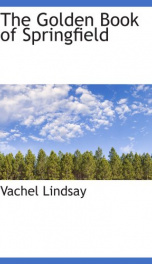
the golden book of springfield
Series:
Unknown
Year:
Unknown
Raiting:
4/5
Vachel Lindsay was the most extremely romantic American poet of his generation. "The Golden book of Springfield" is his only novel. "The Golden book of Springfield" is extremely mystical piece of writing. Lindsey tries to do justice to his home state creating a futuristic Illinios filled with life and dignity. Creating the Illinois that differs from one of his time or anyone else’s. Lindsey has a deep knowledge of the occult which is apparent to anyone who reads this book. The book is steeped in the occult tradition, filled with magic and mysticism. Like ancient vibrations coming off his midwestern landscapes. This book will leave the reader with a certain level of aboveness, for those who understand what he was trying to say.
Show more
add to favoritesadd In favorites
Book list

the wedding of the rose and the lotus a poem written on the near completion of
Series:
Unknown
Year:
Unknown
Raiting:
3/5
Show more
add to favoritesadd In favorites

the golden book of springfield
Series:
Unknown
Year:
Unknown
Raiting:
4/5
Vachel Lindsay was the most extremely romantic American poet of his generation. "The Golden book of Springfield" is his only novel. "The Golden book of Springfield" is extremely mystical piece of writing. Lindsey tries to do justice to his home state creating a futuristic Illinios filled with life and dignity. Creating the Illinois that differs from one of his time or anyone else’s. Lindsey has a deep knowledge of the occult which is apparent to anyone who reads this book. The book is steeped in the occult tradition, filled with magic and mysticism. Like ancient vibrations coming off his midwestern landscapes. This book will leave the reader with a certain level of aboveness, for those who understand what he was trying to say.
Show more
add to favoritesadd In favorites
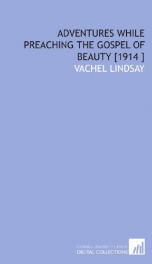
adventures while preaching the gospel of beauty
Series:
Unknown
Year:
Unknown
Raiting:
5/5
Originally published in 1914. This volume from the Cornell University Library's print collections was scanned on an APT BookScan and converted to JPG 2000 format by Kirtas Technologies. All titles scanned cover to cover and pages may include marks notations and other marginalia present in the original volume.
Show more
add to favoritesadd In favorites

a handy guide for beggars especially those of the poetic fraternity being sund
Series:
Unknown
Year:
Unknown
Raiting:
3.5/5
Show more
add to favoritesadd In favorites
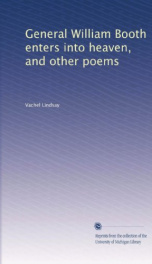
General William Booth Enters into Heaven : and other poems
Series:
Unknown
Year:
Unknown
Raiting:
3/5
This volume is produced from digital images created through the University of Michigan University Library's large-scale digitization efforts. The Library seeks to preserve the intellectual content of items in a manner that facilitates and promotes a variety of uses. The digital reformatting process results in an electronic version of the original text that can be both accessed online and used to create new print copies. The Library also understands and values the usefulness of print and makes reprints available to the public whenever possible. This book and hundreds of thousands of others can be found in the HathiTrust, an archive of the digitized collections of many great research libraries. For access to the University of Michigan Library's digital collections, please see http://www.lib.umich.edu and for information about the HathiTrust, please visit http://www.hathitrust.org
Show more
add to favoritesadd In favorites
What readers are saying
What do you think? Write your own comment on this author!
write a commentGenre
- Books / Art
- Books / American poetry
- Literature & Fiction / Genre Fiction / Action & Adventure
- Law / United States
- Books / Motion pictures
- Nonfiction / Education / Education Theory / History
- Books / Lindsay, Vachel,1879-1931 / Golden book of Springfield
- Books / Newfoundland and Labrador / Description and travel
if you like Lindsay Vachel try:
readers also enjoyed
What readers are saying
What do you think? Write your own comment on this author!
write a commentGenre
- Books / Art
- Books / American poetry
- Literature & Fiction / Genre Fiction / Action & Adventure
- Law / United States
- Books / Motion pictures
- Nonfiction / Education / Education Theory / History
- Books / Lindsay, Vachel,1879-1931 / Golden book of Springfield
- Books / Newfoundland and Labrador / Description and travel
if you like Lindsay Vachel try:
readers also enjoyed
Do you want to exchange books? It’s EASY!
Get registered and find other users who want to give their favourite books to good hands!
